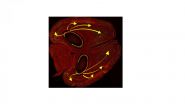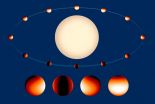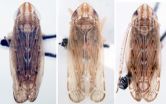INFORMATION:
The research is ongoing and has been funded by the National Science Foundation (NSF), the Air Force Office of Scientific Research (AFOSR) and the Defense Advanced Research Projects Agency (DARPA).
Writer: Emil Venere, 765-494-4709, venere@purdue.edu
Sources: Bryan Boudouris, 765-496-6056, boudouris@purdue.edu
Related websites:
Brian Boudouris: https://engineering.purdue.edu/ChE/People/ptProfile?id=71151
IMAGE CAPTION:
An emerging class of electrically conductive plastics are called "radical polymers." The graphic at left depicts the structure of a polymer. At right, transparent polymer overlays the Purdue logo. (Purdue University photo)
A publication-quality photo is available at https://news.uns.purdue.edu/images/2014/boudouris-radical.jpg
ABSTRACT
Radical Polymers and Their Application to Organic Electronic Devices
Edward P. Tomlinson , Martha E. Hay , and Bryan W. Boudouris *
School of Chemical Engineering, Purdue University
Macromolecules, 2014, 47 (18), pp 6145–6158
*E-mail: boudouris@purdue.edu
Macromolecules bearing stable radical groups have emerged as extremely useful active materials in organic electronic applications ranging from magnetic devices to flexible batteries. Critical to the success of these open-shell polymers has been the readily tunable nature of their molecular architectures; this important molecular structure–property–performance design paradigm has allowed for significant device performance metrics to be achieved. In this Perspective, the recent advancements regarding the design and device functionality of a common class of open-shell macromolecules, radical polymers, are discussed. Here, radical polymers are defined as macromolecules with nonconjugated carbon backbones, whose optoelectronic functionalities arise due to the presence of stable radical sites on the pendant groups of macromolecular chains. This class of materials provides a unique platform for the design of unique optical and electronic properties in soft materials; however, as with many organic electronic materials, transitioning these gains from the laboratory to the commercial scale remains a primary challenge. As such, we provide context for the significant accomplishments that have been made in the field, describe how these advances have been translated to high-performance devices, and discuss future areas of evaluation for these next-generation polymer electronic materials.
Electrically conductive plastics promising for batteries, solar cells
2014-10-10
(Press-News.org) WEST LAFAYETTE, Ind. – An emerging class of electrically conductive plastics called "radical polymers" may bring low-cost, transparent solar cells, flexible and lightweight batteries and ultrathin antistatic coatings for consumer electronics and aircraft.
Researchers have established the solid-state electrical properties of one such polymer, called PTMA, which is about 10 times more electrically conductive than common semiconducting polymers.
"It's a polymer glass that conducts charge, which seems like a contradiction because glasses are usually insulators," said Bryan Boudouris, an assistant professor of chemical engineering at Purdue University.
The polymer is easy to manufacture, resembling Plexiglas, an inexpensive transparent plastic found in numerous products. However, unlike Plexiglas it conducts electricity.
"We make billions of tons of plastic every year," Boudouris said. "So imagine if you could produce that same kind of material at that same scale but now it has electronic properties."
The PTMA is in a class of electrically active polymers that could bring inexpensive transparent solar cells; antistatic and antiglare coatings for cellphone displays; antistatic coverings for aircraft to protect against lightning strikes; flexible computer flash drives; and thermoelectric devices, which generate electricity from heat.
The polymers have seen commercial use in new types of batteries. However, finding widespread practical applications for the polymers will require increasing the conductivity another 100 to 1,000 times, Boudouris said.
Recent research findings were detailed in a paper published online in May in the journal Macromolecules. A review article on the subject appeared in September in the same journal and is featured on the cover. The American Chemical Society also has recorded a series of podcast with Boudouris, accessible at http://pubs.acs.org/page/mamobx/audio/index.html.
The review article is authored by Purdue graduate students Edward P. Tomlinson and Martha E. Hay, and Boudouris. The research article published in May was authored by graduate student Lizbeth Rostro, undergraduate student Si Hui Wong, and Boudouris.
Polymers are strings of molecules with a central backbone and may contain side chains called "pendant groups" that dangle from the central structure. In radical polymers, it's these pendant groups that allow charge to be transported, conducting current.
To create the radical polymer, the researchers used a procedure called deprotection, which involves replacing a specific hydrogen atom in the pendant group with an oxygen atom, converting it into a so-called radical group.
"We just finally studied deprotection in a way others had not to learn how it affects the electronic properties of the radical polymers," Boudouris said.
Electrons surround an atom's nucleus in "shells" and these electrons are usually paired. The oxygen atom in PTMA, however, has one unpaired electron in its outer shell, making it amendable to transporting charge.
"You have to control the deprotection process very well because it makes the conductivity vary by orders of magnitude," he said.
The researchers have determined that the deprotection step can lead to four distinct chemical functionalities of the radical polymer, two of which are promising for increasing the conductivity of the polymer.
"So manipulating the reaction conditions for this deprotection step, and monitoring closely the resultant chemical functionalities, is critical in tuning the electrical properties of radical polymers," Boudouris said.
ELSE PRESS RELEASES FROM THIS DATE:
Migrating animals' pee affects ocean chemistry
2014-10-09
The largest migration on the planet is the movement of small animals from the surface of the open ocean, where they feed on plants under cover of darkness, to the sunless depths where they hide from predators during the day.
University of Washington researchers have found that this regular migration helps shape our oceans. During the daylight hours below the surface the animals release ammonia, the equivalent of our urine, that turns out to play a significant role in marine chemistry, particularly in low-oxygen zones. Results are published online this week in the Proceedings ...
Penn Medicine's 'sepsis sniffer' generates faster sepsis care and suggests reduced mortality
2014-10-09
PHILADELPHIA - An automated early warning and response system for sepsis developed by Penn Medicine experts has resulted in a marked increase in sepsis identification and care, transfer to the ICU, and an indication of fewer deaths due to sepsis. A study assessing the tool is published online in the Journal of Hospital Medicine.
Sepsis is a potentially life-threatening complication of an infection; it can severely impair the body's organs, causing them to fail. There are as many as three million cases of severe sepsis and 750,000 resulting deaths in the United States ...
Manipulating memory with light
2014-10-09
Just look into the light: not quite, but researchers at the UC Davis Center for Neuroscience and Department of Psychology have used light to erase specific memories in mice, and proved a basic theory of how different parts of the brain work together to retrieve episodic memories.
Optogenetics, pioneered by Karl Diesseroth at Stanford University, is a new technique for manipulating and studying nerve cells using light. The techniques of optogenetics are rapidly becoming the standard method for investigating brain function.
Kazumasa Tanaka, Brian Wiltgen and colleagues ...
Space-based methane maps find largest US signal in Southwest
2014-10-09
ANN ARBOR—An unexpectedly high amount of the climate-changing gas methane, the main component of natural gas, is escaping from the Four Corners region in the U.S. Southwest, according to a new study by the University of Michigan and NASA.
The researchers mapped satellite data to uncover the nation's largest methane signal seen from space. They measured levels of the gas emitted from all sources, and found more than half a teragram per year coming from the area where Arizona, New Mexico, Colorado and Utah meet. That's about as much methane as the entire coal, oil, ...
Plant communities in Holy Land can cope with climate change of 'biblical' dimensions
2014-10-09
An international research team comprised of German, Israeli and American ecologists, including Dr. Claus Holzapfel, Dept. of Biological Sciences, Rutgers University-Newark, has conducted unique long-term experiments in Israel to test predictions of climate change, and has concluded that plant communities in the Holy Land can cope with climate change of "biblical" dimensions. Their findings appear in the current issue of Nature Communications at http://www.nature.com/ncomms/2014/141006/ncomms6102/pdf/ncomms6102.pdf.
When taking global climate change into account, many ...
NASA's Hubble maps the temperature and water vapor on an extreme exoplanet
2014-10-09
A team of scientists using NASA's Hubble Space Telescope has made the most detailed global map yet of the glow from a turbulent planet outside our solar system, revealing its secrets of air temperatures and water vapor.
Hubble observations show the exoplanet, called WASP-43b, is no place to call home. It is a world of extremes, where seething winds howl at the speed of sound from a 3,000-degree-Fahrenheit "day" side, hot enough to melt steel, to a pitch-black "night" side with plunging temperatures below 1,000 degrees Fahrenheit.
Astronomers have mapped the temperatures ...
DNA nano-foundries cast custom-shaped metal nanoparticles
2014-10-09
Researchers at the Wyss Institute for Biologically Inspired Engineering at Harvard University have unveiled a new method to form tiny 3D metal nanoparticles in prescribed shapes and dimensions using DNA, Nature's building block, as a construction mold.
The ability to mold inorganic nanoparticles out of materials such as gold and silver in precisely designed 3D shapes is a significant breakthrough that has the potential to advance laser technology, microscopy, solar cells, electronics, environmental testing, disease detection and more.
"We built tiny foundries made ...
Balancing birds and biofuels: Grasslands support more species than cornfields
2014-10-09
MADISON, Wis. – In Wisconsin, bioenergy is for the birds. Really.
In a study published today in the journal PLOS ONE, University of Wisconsin-Madison and Wisconsin Department of Natural Resources (DNR) scientists examined whether corn and perennial grassland fields in southern Wisconsin could provide both biomass for bioenergy production and bountiful bird habitat.
The research team found that where there are grasslands, there are birds. Grass-and-wildflower-dominated fields supported more than three times as many bird species as cornfields, including 10 imperiled ...
New leafhopper species named after University of Illinois entomologist
2014-10-09
Three new species of leafhoppers from China in the genus Futasujinus were recently identified during a review of leafhoppers in museum collections in China, the UK, and Illinois. One of them, Futasujinus dietrichi, was "named after Dr. Chris Dietrich, University of Illinois, USA, in recognition of his good work on leafhoppers." The new species are described in an article in Annals of the Entomological Society of America.
The other two species are Futasujinus truncatus and Futasujinus hastatus. Both species epithets allude to processes on their aedeagal shafts.
All three ...
Ebola research shows rapid control interventions key factor in preventing spread
2014-10-09
Tempe, Ariz. (Oct. 9, 2014) - New Ebola research demonstrates that quick and forceful implementation of control interventions are necessary to control outbreaks and avoid far worse scenarios.
Researchers analyzed up-to-date epidemiological data of Ebola cases in Nigeria as of Oct. 1, 2014, in order to estimate the case fatality rate, proportion of health care workers infected, transmission progression and impact of control interventions on the size of the epidemic.
"Rapid and forceful control measures are necessary as is demonstrated by the Nigerian success story. This ...



